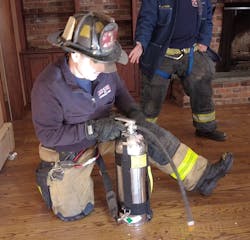The water can, or the stored-pressure extinguisher, or “the can,” is a vital piece of firefighting equipment that we all have worked with, whether it was during training at the fire academy or using it to cancel an engine company. It carries 2½ gallons, weighs about 30 lbs., has a stream range of about 40 feet and can flow about 55 seconds. It can be used for almost everything, from knocking back a decent amount of fire, to throwing off a well-developed room, to chalking a door open, to mopping up a smoldering fire pit, and even as a wall breaching tool. In other words, the can is invaluable, but the real question is how often do you train with it?
One of the first things that should be understood is how to use the can and how to maintain it.
The basics
The majority of water cans are rather rugged and don’t require much care besides checking the rubber hose and the gasket that’s within the stem for dry rot.
Be mindful that the handle might be damaged and bent into a funky position that will minimize the full potential of engaging the can.Another issue that you might encounter is the plastic base cover breaking off. The plastic cover is cosmetic and allows the can to stand freely without any support. It depends on your department and policies whether a broken base cover requires the can to be put out of service.
A common issue that likely everyone experienced at least once is a missing pin. You can get creative by using paracord or an elastic strap from a nonrebreather mask to secure the pin to the top tab on the can. Further, once you pull the paracord, etc., you don’t have to worry about maintaining the pin or trying to put it in a pocket.
Filling
When filling up a can, make sure that it’s depressurized. Flip the can upside down so that the handle points down to the ground and squeeze the handle. This evacuates the pressurized air.
Next, unscrew the stem assembly. Fill the can with 2½ gallons of water. Screw the stem assembly back on.
If your can has a nozzle clip on the base, make sure to orient the hose in line with it.
Recharge the can with an air line. Be mindful to not stare directly into the gauge. Look at it from an angle, in the event that it lets go. Fill the can until the gauge is in the green.
Operating
Operating a water can is simple: Pull the pin, aim at the fire, squeeze the handle and sweep the nozzle at your target.
Note: Sweeping is more for when we teach civilians to use their dry chemical extinguisher, for example, in their office space in the event of a small waste basket fire. As firefighters, we should apply everything that we know and understand about working a handline to the nozzle of the can. As we move and whip the nozzle of the can around, we disperse the water through the entire area that we work. Now, if we just discharge the can in one spot, we still have the ability to do damage in that immediate area, but we might miss the majority of our problem.If you make a fire room or area and have the opportunity to make a rescue, open up and work that can. You might be surprised by what 2½ gallons can do to a fire.
Don’t forget about the basic trick of using the tip of your finger to manipulate the stream into a wide pattern.
The next time that you have the opportunity to conduct a live burn training, work on the can. Open it up and see what it can do. As always, the effect that the 2½ gallons of water that are in the can have depends on the situation and the extent of the fire.
Moving with the can
Another concept that should be discussed prior to game day is simply moving with the can. On daily routine incidents, such as fire alarms, odors of smoke and culinary disasters, we might leave the can at the front door or just carry it around normally. We’re in our normal position, standing up with the can in one hand or on one shoulder on the sling that some include. That’s easy; there’s nothing to worry about. No stress.
Now, consider a situation where you’re in a high-stress environment. Perhaps you’re the first-due truck searching for a confirmed victim in no-visibility conditions with high heat all around you. Your body position is completely different. You no longer are able to be standing. You would be down low to the floor, just getting beneath the smoke layer, where you can see faint flickers of flames coming out of a room. The can isn’t on your shoulder any longer. You’re down, pushing down the hallway, and you find yourself with a tool in one hand and a can in the other hand, dragging it behind you by the shoulder strap.
There are numerous ways to carry the can. Some people will use the strap, as noted above. Some will carry it by the handle. Some will “hulk” it by carrying it under one arm. Some will clip the strap into the carabiner of their bunker pants.
One thing to mention about the last option: It allows you to maintain your orientation with the can, and it becomes more difficult to lose the can in chaotic situations. However, it does create an anchor, and you are limited to the range of motion within the clipped strap.
Whichever method that you prefer, train on it. You can’t show up at a fire and hope for the best.
Have conversations
Take some time to discuss the can. When to use it? In what scenarios would you depend on it? How will you move with it? How long can you operate it?
Perhaps you’ll develop your own methods with it. Perhaps you’ll choose to flow with it intermittently to cool a room while you conduct a swift primary search.
Some choose to add a little bit of soap to create a little “foam.” Some put a little bit of antifreeze in it for the winter if the can is stored outside of a compartment to avoid it freezing up.
As common as the water can is, start a discussion at the kitchen table and see where it goes.
About the Author

Robert Policht
Robert Policht, who is a Firehouse contributing editor, is lieutenant of Ladder Co. 2 of the Passaic, NJ, Fire Department. He assisted with developing and establishing the department’s response to human vs. machine incidents and is attached to the Fire Investigation Unit. Policht started his career as a volunteer and has served as a chief of department. He taught at the Bergen County, NJ, Fire Academy and is a member of the NJ Division of Fire Safety's Fire Threat Task Force. Policht has a master’s degree in emergency management and homeland security from Arizona State University and has been published in several trade publications. He is a founder of and contributor to Flow and Vent, which is a website that's dedicated to fire and rescue training.


